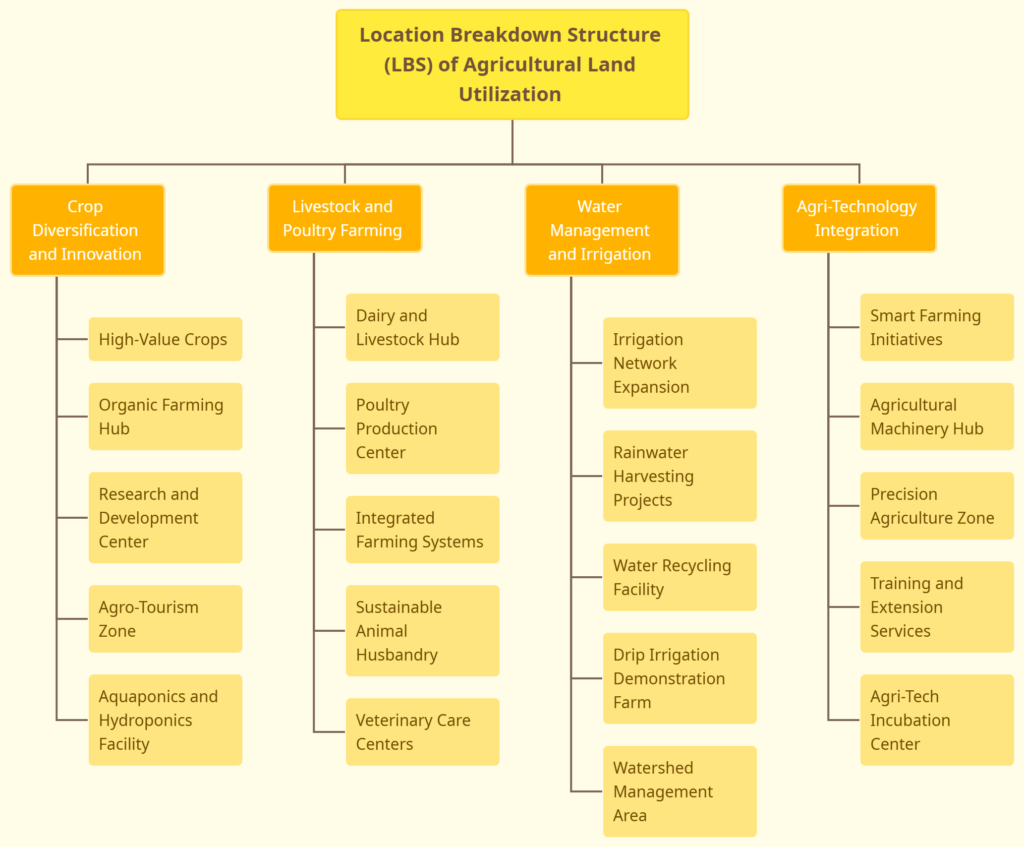
Navigating Agricultural Diversity through LBS
The Location Breakdown Structure (LBS) of Agricultural Land Utilization mind map presents a structured approach to optimizing agricultural landscapes for sustainable and diversified land use. The main categories within the structure include Crop Diversification and Innovation, Livestock and Poultry Farming, Water Management and Irrigation, and Agri-Technology Integration. Each category delves into specific zones and projects that contribute to the overall efficiency and productivity of agricultural land. For example, Crop Diversification and Innovation feature zones like High-Value Crops, Organic Farming Hub, Research and Development Center, Agro-Tourism Zone, and Aquaponics and Hydroponics Facility, highlighting a holistic approach to crop management. Livestock and Poultry Farming cover aspects such as Dairy and Livestock Hub, Poultry Production Center, Integrated Farming Systems, Sustainable Animal Husbandry, and Veterinary Care Centers, emphasizing a balanced and sustainable approach to animal agriculture. Water Management and Irrigation include projects like Irrigation Network Expansion, Rainwater Harvesting, Water Recycling Facility, Drip Irrigation Demonstration Farm, and Watershed Management Area, showcasing the importance of efficient water use. Lastly, Agri-Technology Integration explores zones like Smart Farming Initiatives, Agricultural Machinery Hub, Precision Agriculture, Training and Extension Services, and an Agri-Tech Incubation Center, reflecting the integration of technology for enhanced agricultural practices. This mind map provides valuable insights into the strategic planning required for optimizing agricultural land utilization and promoting sustainable farming practices.
Harnessing the Power of LBS for Land Development
The Location Breakdown Structure (LBS) serves as a valuable tool in the development of ideas for agricultural land utilization by providing a systematic framework for planning and organization. It helps stakeholders break down complex concepts into manageable categories and subcategories, facilitating a clearer understanding of various aspects of land use. The structured nature of the LBS allows for the identification of key zones, projects, and initiatives that contribute to the overall success of the agricultural development plan. Through this breakdown, stakeholders can prioritize and strategize the implementation of ideas, ensuring a comprehensive and coordinated approach to land utilization. The LBS also fosters collaboration among different teams or stakeholders by providing a shared visual representation, fostering a common understanding of the project goals and components. In essence, the LBS acts as a roadmap, guiding the development and implementation of ideas for optimizing agricultural land and promoting sustainable practices.
Power of LBS in Planning with VP Smart Board
The Location Breakdown Structure (LBS) finds common use in various industries, notably in urban planning, project management, and agriculture. In urban planning, an LBS might be employed to categorize different districts, such as residential, commercial, and industrial zones, enabling a comprehensive understanding of land utilization within a city. In project management, the LBS assists in organizing project components geographically, aiding in efficient resource allocation and task coordination. In agriculture, as exemplified in the LBS of Agricultural Land Utilization, it categorizes different aspects like crop diversification, livestock farming, water management, and agri-technology, providing a structured approach to optimize land use for sustainable farming.
Choosing the LBS is advantageous for its ability to provide a visual and systematic representation of complex ideas, fostering clarity and facilitating decision-making. As an advocate for seamless and effective mind mapping, Visual Paradigm Smart Board further enhances the utility of the LBS. With its intuitive interface and diverse templates, Visual Paradigm Smart Board simplifies the process of creating LBS and other mind maps, ensuring that users can effortlessly translate intricate ideas into visually engaging and well-organized structures, promoting efficient planning and decision-making across various domains.